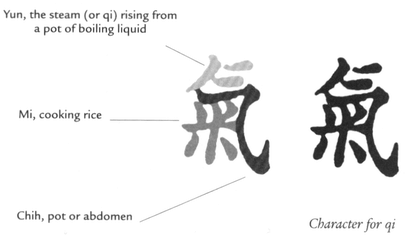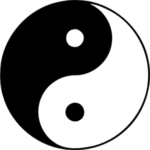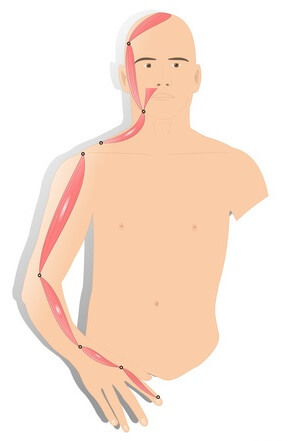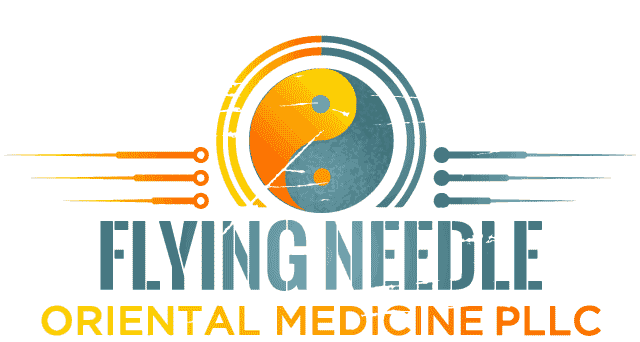In my blog and throughout the Flying Needle website, “Qi” is frequently mentioned. So, I would like to give some definition to Qi. Future blog posts will add to the depth of this definitional post as they discuss how Qi affects our health via the pathological manifestations of excess Qi, diminished Qi, or blocked Qi. The very foundations of traditional Chinese medicine (TCM) are based on intricate Qi pathways called meridians and the natural balance of Qi as it moves through these pathways and heats our bodies.
Qi: A Definition
Wikipedia defines Qi as: “In traditional Chinese culture, qì or ch’i is believed to be a vital force forming part of any living thing. Qi literally translates as “breath”, “air”, or “gas”, and figuratively as “material energy”, “life force”, or “energy flow”. Qi is the central underlying principle in traditional Chinese medicine and Chinese martial arts. Despite widespread belief in the reality of qi, it is a non-scientific, unverifiable concept.”
My understanding of this beautiful, intelligent energy is that it is a living force that we share with the universe which has gifted us with life and formed our bodies.
 The Chinese Qi ideogram is written in two parts. As shown at the right, the upper part represents steam, air, clouds…a firmament. And the bottom part represents a kernel of rice as it explodes open while cooking in its pot.
The Chinese Qi ideogram is written in two parts. As shown at the right, the upper part represents steam, air, clouds…a firmament. And the bottom part represents a kernel of rice as it explodes open while cooking in its pot.
The classic Chinese texts indicate that Qi is the very spark of life.
 In early drawings of the Taijitu (the well-known yin/yang symbol at right), the area between yin and yang or heaven and earth where man is created and Qi flows is represented as a spiral indicating movement.
In early drawings of the Taijitu (the well-known yin/yang symbol at right), the area between yin and yang or heaven and earth where man is created and Qi flows is represented as a spiral indicating movement.
Dr. Daniel Keown, author of The Spark in the Machine, also points out that the importance of spiral forms is evident in many ancient cultures. This spiral energy (Qi) transforms matter and its path can be seen in Fibonacci forms like seashells, whale fins, and ferns.
In the 4th century BCE, the activity of Qi was described, by the ancient Taoists, moving through the extraordinary channels as the cells divide within the embryo. The ancient ones said the one begets two. The two begets three, and the three beget 10,000 things.
Following this philosophy, we can look at the first few weeks of embryonic development. A man joins a woman (from one to two), sperm to egg. There is a brief quiet period after fertilization of the egg, and then an explosion of creation follows (the three and creation). Not unlike the depiction of the qi ideogram’s rice kernel exploding into many pieces.
What determines gene expression? How do the cells know? According to ancient writing, the Taoists were aware of a connection between Qi and gene expression. Take a look at the video at right that shows the development of a frog embryo. It shows what may be bioelectric movement in the embryo preceding gene expression. Could this also be Qi?
 If Qi is involved in our fetal growth, then we should be able to find relationships between channels/ meridians and embryonic development. Let’s take a look at the Lung and Large Intestine channels to see if there is a connection. The lung channel ends in the tip of the thumb, and the large intestine channel begins at the tip of the second (index) finger. What is the connection between the Lung, Gut, and Thumb? As stated by Duke Education, “The lungs along with the heart and stomach develop from the embryonic gut and as a result share neural crest cells which regulate the enteric nervous system by controlling secretory activity and the production of mucous.” This makes sense. We have mucous in both our lungs and our gut. Better yet, the lungs develop from the embryonic gut. Hmmm!
If Qi is involved in our fetal growth, then we should be able to find relationships between channels/ meridians and embryonic development. Let’s take a look at the Lung and Large Intestine channels to see if there is a connection. The lung channel ends in the tip of the thumb, and the large intestine channel begins at the tip of the second (index) finger. What is the connection between the Lung, Gut, and Thumb? As stated by Duke Education, “The lungs along with the heart and stomach develop from the embryonic gut and as a result share neural crest cells which regulate the enteric nervous system by controlling secretory activity and the production of mucous.” This makes sense. We have mucous in both our lungs and our gut. Better yet, the lungs develop from the embryonic gut. Hmmm!
Limb and lung development seem to be related, also.
Upper limb outgrowth of the anterior and posterior girdles (meaning the anterior and posterior hand, specifying the thumb), and branching of the bronchial tree share the growth factor FGF10. This means that when the thumb and index finger branch, so does the bronchial tree of the embryonic lung due to a specific shared growth factor. I’ve observed baby’s sucking their thumbs in-utero via ultra-sound, and considering this observation along with the above knowledge makes me wonder if thumb sucking is stimulating healthy lung maturation? As a result of this information, I encourage parents to let their babies suck their thumbs.
I would like to state my opinion that differs from Wikipedia in hopes of challenging you to consider the same. To me, Qi has been verified. I’m convinced Qi is intelligent. I believe it forms and fills our bodies and possibly the universe. Frequently, a sense of awe comes over me as I treat my patients. As I work with this energy using acupuncture, acupressure, herbs, oils, and medical Qigong, there is no denying that we are awesome and fearsomely made creatures.
Fellow TCM practitioners, please keep in mind that within each patient you treat, an intelligent and creative life force is spiraling through their meridians capable of healing the body it helped to create. Patients and those considering introducing Traditional Chinese Medicine into their lives, explore the possibilities that balancing their Qi energy can bring.

